In the late 1890’s the Catholics of Italian heritage residing in New Castle, Pennsylvania, had mainly been attending services at St. Joseph Catholic Church, a predominantly German-ethnic congregation. Finally, in 1900, the Reverend Francis J. Eger, the pastor of St. Joseph’s, helped establish an Italian-ethnic congregation that became known as the St. Vitus Catholic Church. The new congregation, centered in the Fifth Ward or “South Side” of New Castle, was named in honor of St. Vitus of Sicily, who is said to have died a martyr during the persecution of Christians in 303 A.D. The name was apparently taken directly from St. Vito Catholic Church, a congregation some of the parishioners had attended back in the village of Baia Latina in Caserta, Italy.
The new congregation, after appealing to the Diocese of Pittsburgh for assistance, was soon supplied by widely-traveled Italian priests from the Order of Friars Minor (OFM), better known as Franciscans. The Reverend Leonardo Cantelmi, with several assistants, was immediately dispatched to assume the role of pastor. The former Primitive Methodist Church at South Jefferson and Maitland Streets was purchased for use by the congregation in early November 1900. The building was quickly remodeled and opened for services on Christmas Day, Tuesday, December 25, 1900.
The Reverend Cantelmi was succeeded by fellow friars to include Alessandro (or Alexander) Scapigliati from 1901-1902 and Anacletus DeAngelis from 1902-1905. DeAngelis (1836-1905), born in Rome, Italy, was a prominent and well accomplished clergyman of the Franciscan order. He studied theology in his home country, joined the Franciscan order in 1856, and was sent to the United States a decade later. After assignments near Hartford, Connecticut, and Buffalo, New York, he was appointed in 1877 as pastor of St. Anthony of Padua Catholic Church in New York City – the first Catholic parish in the country established solely for Italian immigrants. From 1890 until 1896 he held the lofty office of “Provincial,” overseeing the affairs of all Franciscan friars in the United States. He also served as the president of St. Bonaventure College and Seminary in western New York, an educational institution maintained by the Franciscans. In the late 1890’s he was dispatched to serve the Italian community within the Diocese of Pittsburgh.
In the early 1900’s the burgeoning local fireworks industry became closely associated with celebrations within the Italian communities of Lawrence County, including those on the South Side of New Castle. Almost all of the prominent fireworks men were of Italian heritage and were members of St. Vitus Church. Among the parishioners you would eventually find the surnames of Fazzoni, Rozzi, Conti, Peluso, Vitale, Perrone, and Zambelli.
Fireworks displays held in honor of the church became almost commonplace and one such display was recorded in the New Castle News of Tuesday, June 18, 1901: “St. Vitus was honored by the local Italian church Saturday with impressive ceremonies and a grand exhibition of fireworks. Mass was celebrated at 9:30 a. m. and high mass at 10 o’clock. In the evening vespers and benediction was held. Father Lenardo, pastor of the church, was assisted at the exercises by Father Buenaventura of Pittsburg, and Rev. Eger of this city. The fireworks were put off in the evening on South Jefferson street near Rosena furnace. They were under supervision of the Fazzoni brothers and Prof. G. Peluso, and included some of the prettiest set pieces ever seen here.” The fireworks industry grew in the shadow of the church, and together they both experienced tremendous growth in the coming years.
The Reverend DeAngelis faithfully served the congregation of St. Vitus for several years before suffering an unfortunate accident on Monday, May 1, 1905. The New Castle News of Wednesday, May 3, 1905, reported, “Very Rev. Father Anacletus DeAngelis, pastor of St. Vitus’ Catholic Church of this city, and a far more distinguished churchman than many New Castle people realized, passed away at 7 o’clock Tuesday evening at the hospital here, from injuries received the evening before in falling from a moving Lake Erie passenger train, from which he attempted to alight at the Moravia street crossing. From the first it was feared he had suffered internal injuries and peritonitis developed late Tuesday afternoon, causing his death within a few hours… Father Anacletus was truly a man of the utmost largeness of heart and labored faithfully for mankind. He was courtesy itself and was so gentle in spirit that he won all with who he came in contact, so that the regret over his death will be very general.”
A solemn memorial service was held on Thursday, May 4, 1905, and was attended by the Right Reverend J. F. Regis Canevin, who served as the Bishop of Pittsburgh from 1904 to 1920. The Reverend Joseph F. Gallagher, pastor of the St. Mary’s Catholic Church, served as the celebrant of the service. DeAngelis was subsequently buried in the cemetery on the campus of St. Bonaventure College. The Reverend Alexander Scapigliati, who had previously served at St. Vitus before DeAngelis took over in 1902, temporarily reassumed the role of pastor. Two months later the Reverend (Settimio) Wenceslaus Parenti, a fellow Franciscan, took over as Scapigliati returned to Pittsburgh to act as assistant pastor at St. Peter’s Catholic Church.
Meanwhile, the St. Vitus congregation, which had generally been using St. Joseph’s Cemetery in Neshannock Township as a burial ground, purchased the King farm out in Shenango Township and established a cemetery that was dedicated on Sunday, June 11, 1905. The New Castle News of Wednesday, June 14, 1905, mentioned, “In years past the Italians of New Castle, have boon burying their dead in St. Joseph’s cemetery and some time ago decided to purchase a congregational cemetery which will be directly under the control of the pastor and trustees.”
In the fall of 1905 the Franciscan priests withdrew and the relinquished control of St. Vitus Parish. Bishop Canevin dispatched a young diocesan priest named Nicholas DeMita (1877-1956) to temporarily assume the role of pastor of the church. The congregation was immediately enamored with him and requested he remain as their permanent pastor. The request was granted the DeMita was installed as the permanent pastor on Sunday, September 24, 1905.
DeMita, the son of Michael & Philomena DeMita, was born in Nusco, Italy, on November 29, 1877. He entered a seminary at a young age and was ordained in September 1900. In May 1904, at the age of twenty-six, he decided to head to Pennsylvania to join the Diocese of Pittsburgh and preach to his fellow Italian immigrants. Sixteen months later he was sent to New Castle, where he quickly assumed a leading role among Italian Catholics.
He served as pastor of St. Vitus, chaplain of St. Francis Hospital, and established a Catholic mission in the village of Hillsville in 1906. He provided services at that outlying mission until it became the independent St. Lawrence Catholic Church/Parish in 1909. DeMita also helped establish the Catholic Anti-Black Hand Society, an organization committed to battling the influence of the Italian crime syndicate known as the Black Hand. His calming presence also helped to better the image of Italians, who many people viewed as troublemakers.
Upon his arrival DeMita immediately set out to raise funds to establish a new church for the 400 families in his congregation. His efforts were extremely successful and he was able to raise over $70,000. Construction started in the summer of 1906 on a new brick church and the cornerstone was laid on August 15, 1906. The new church, capable of seating 700 people, and a rectory were dedicated by the Bishop Canevin on Thursday, August 15, 1907.
The New Castle News of Wednesday, August 14, 1907, mentioned the pending dedication with, “Everything is in readiness for the consecration of St. Vitus’ Italian Catholic church at the corner of Maitland and South Jefferson streets, which will he dedicated to public worship Thursday by Bishop Canevin of Pittsburg. In connection with the dedication the feast of assumption will be observed, the actual observance of this event beginning with vespers in the old church Wednesday evening and orchestra recital by the Niles, O., Italian band. This will be held at the southern end of Jefferson street. There will also be an elaborate electrical illumination. The street and buildings in the neighborhood of the new church have been gayly decorated with flags and banners bearing inscriptions.”
The same article went on to mention the actual ceremony with, “Beginning at 7 o’clock Thursday, there will be some kind of services during the entire day and evening. The dedicatory services will begin at 10 o’clock. The first part of this will consist of the blessing of the walls on the outside by Bishop Canevin. The latter and the attending priests, about 20 in all, will march twice around the building, sprinkling holy water on the ground. Following this, the bishop will enter the church alone, and recite the litany on the altar steps. Following this will be the solemn pontifical mass, Bishop Canevin officiating. The dedicatory mass will be said at 10:30. Rev. F. J. Eger of St. Joseph’s church, will be the officiant… Father Biscope of Sharpsville will preach in Italian and Bishop Canevin will deliver a sermon in English. Other visiting priests will assist in the services.”
The New Castle News of Friday, August 16, 1907, carried an editorial entitled “New Castle’s Italians” which read, “New Castle has thousands of the better class of Italians numbered among her citizens. These demonstrated their interest in the better things of life when they yesterday devoted the day and evening to the dedication of their new church on South Jefferson street. So much has been printed about the unlawful conduct of the comparatively few criminally inclined Italians who are members of the Black Hand blackmailing pact, that the public mind is in danger of being inclined to the belief that Italians generally are of the careless class. But such is not the case. The bad class of Italians are in the minority, while the thrifty, law-obeying, orderly class are greatly in the majority. Unfortunately the poor understanding which the elder Italians have of the English language and American ways is responsible for their tolerance of the wrongful acts of the Black Hand members of their nationality. Father DeMita is to be congratulated on his handsome new church, auspiciously opened yesterday and the enthusiasm of his great parish.”
The first funeral service was held in the church the day after it was dedicated. The New Castle News of Friday, August 16, 1907, disclosed, “The first funeral to be held in the newly dedicated St. Vitus’ church, was held Friday morning at 9 o’clock, when many friends and fellow countrymen gathered for the funeral of Petero Grasziano. Requiem mass was celebrated by the pastor, Father DeMito, the services being solemn and beautiful. The interment was at St. Vitus’ cemetery.”
The basement of the St. Vitus Church also became home to a parochial school, initially housing about 250 pupils, beginning in September 1908. The school was under the care of the Missionary Franciscan Sisters of the Immaculate Conception, an order established in Minnesota in 1873.
The congregation of St. Vitus grew steadily and in late 1911 the DeMita began efforts to establish a mission church in the area of Mahoningtown. Most of the Italians from Mahoningtown had been attending services at St. Vitus for a number of years. The new mission would be known as St. Lucia Catholic Church, or more popularly as St. Lucy’s. A small wooden church was built on South Liberty Street and dedicated during a ceremony on Sunday, October 27, 1912. DeMita and his assistant pastor, the Reverend Dominic Ronco, had supervision over the new congregation – until it was granted official church status and given its own parish in late 1913.
DeMita had a dream to build a dedicated parochial school and by the end of 1915 it seemed he was close to making that happen. The New Castle News of Thursday, March 2, 1916, reported, “As a result of the wonderful financial success of the annual spaghetti supper of St. Vitus’ church, held Monday and Tuesday evenings in the Umberto First hall on Division street, the Rev. Fr. N. DeMita, pastor of the church, expects to realize his ambition of erecting a handsome parochial school building in about one year’s time… The parochial school building as planned by Fr. DeMita will be three stories high, and is to cost $30,000. It will stand on a plot of ground 90×60 feet and the entrance is to be on Maitland street.” Fundraising efforts continued throughout the year, but the monumental events of the Great War (World War I) apparently shelved the entire project.
DeMita officiated over many weddings at the church including that of his own niece in the fall of 1920. The New Castle News of Wednesday, September 1, 1920, reported, “A wedding of more than usual interest will be an event of Thursday morning at 9:30 o’clock at St. Vitus church. South Jefferson and Maitland streets, when Miss Philomena DeMita, daughter of Mr. and Mrs. Angelo DeMita of 1115 Haslage avenue, Pittsburgh, Pa., and niece of Rev. Nicholas DeMita, pastor of St. Vitus church, becomes the bride of Joseph Mangieri, son of Mr. and Mrs. Frank Mangieri of 302 Lutton street… The bride-elect, Miss DeMita is well known here, having come to this city as a child to reside with her uncle, Rev. Fr. DeMita. She is a graduate of St. Vitus parochial school, a Pittsburgh high school and Duff’s Iron City Business College, where she completed a course in banking.”
In the early summer of 1928 the Missionary Franciscan Sisters of the Immaculate Conception, after two decades of service, signaled their intention to withdraw from the St. Vitus School. The overcrowded parochial school, now with about 300 pupils, was left in a state of limbo. This greatly concerned DeMita but he endeavored to find new teachers.
DeMita soon undertook a trip to his native country of Italy. The New Castle News of Tuesday, June 19, 1928, detailed his prior accomplishments, the pending trip, and his intention to secure new teachers: “To him belongs the credit of the erection of several Italian churches in the Diocese of Pittsburgh, especially in Freedom, McKees Rocks, Blairsville and Mt. Pleasant. Coming here in 1905, he started to make the New Castle Parish one of importance and the present magnificent church was erected through his efforts and also the churches in Hillsville and Mahoningtown… While in Rome, he plans to assure the stability of the teaching force of his school and will take steps to have sisters appointed for his parish school who are best adapted to the Italian American Youth. He carries with him, not only the best wishes of his parish but also of the people of the city in general. On landing in France, he will cross France, visiting Paris and other points of interest on his way to Italy.”
DeMita spent several months in Italy and the New Castle News of Friday, September 7, 1928, mentioned, “St. Vitus parochial school will not open until after the middle of the present month it was announced today. It will open shortly after the return of Fr. N. DeMita the pastor who has been spending several months in Italy.” The initiative to acquire the services of new teachers was apparently fruitless. DeMita was forced to close the school, after two decades of operation, upon his return.
The old convent was placed on a foundation as the New Castle News of Wednesday, November 1, 1933, reported, “Workmen are busily engaged excavating a basement in the yard of the St. Vitus church. A house which some years ago was used by sisters, who taught in the St. Vitus parochial school, will be moved and placed on the foundation. Rev. Nicholas DeMita, pastor of the church, announced that the work will take about one month. The basement will be used as a recreation hill by the members of the Knights of St. Vitus organization. The entire house has been turned over to the Knights of St. Vitus club by the members of the church.”
DeMita continued to seek out teachers and in 1937 he was finally able to gain the services of the Missionary Zelatrices of the Sacred Heart (MZSH), based in New Haven, Connecticut. On Sunday, October 8, 1937, a new convent, located beside the church, was dedicated to house the incoming sisters, who had recently arrived to act as instructors for school and associated youth programs of the church. An informal mission of some sort, catering to Catholic women in the Croton neighborhood of New Castle, was maintained by the sisters throughout the 1940’s and 1950’s.
DeMita became one of the most recognized priests of New Castle and his congregation grew to include over 1,600 families by 1950. The congregation numbered about 6,000 people of which half were children. DeMita never gave up on his dream for a modern school. In early 1950 he commenced a successful fund raising drive and ground was broken for a new parochial school next to the church and convent in March 1950. The new school, which would initially house about 600 pupils and soon contained fourteen rooms, was formally dedicated during a ceremony on Sunday, July 15, 1951. In 1953 a campaign was started to raise funds to remodel and enlarge the existing convent. The “new” convent was re-dedicated during a ceremony on Sunday, September 27, 1953.
DeMita, who celebrated his fiftieth year as the pastor of St. Vitus in October 1955, passed away after an extended illness on Monday, May 7, 1956, at the age of seventy-eight. His death was truly a great loss to his parishioners and the community at large. A special mass, presided over by the Most Reverend John F. Dearden, the Bishop of Pittsburgh (from 1950 to 1958), was celebrated in his honor at St. Vitus on Friday, May 11, and afterwards he interred at St. Vitus Catholic Cemetery in Shenango Township.
He was succeeded as pastor by the Italian-born Reverend Joseph F. Fabbri, the former pastor of the St. Lawrence Church in Hillsville and the Purification of the Blessed Virgin Mary Church in Ellwood City. One of Fabbri’s first initiatives was to enlarge the parochial school. Construction of a new wing, along Home Street, was started in May 1959. The building, designed for use with the junior high level students, contained four classrooms, a library, and a large auditorium-gymnasium. It was dedicated during a ceremony, attended by the Most Reverend John J. Wright, the Bishop of Pittsburgh (from 1959-1969), on Sunday, February 21, 1960.
In the early 1960’s, with overcrowding a serious issue, efforts began to raise funds to build a new and larger church and adjoining rectory. The plans for the circular-style structure, designed by Youngstown-based architect P. Arthur D’Orazio, won numerous national design awards. In November 1961 construction started – at the corner of Maitland Street and South Mercer Street – right next to the old church building. The cornerstone was laid on December 17, 1962, and the new edifice was dedicated during a grand ceremony on Thursday, August 15, 1963. Bishop Wright led the ceremonies that were attended by well over 100 priests from around the region. The older church was torn down a few years later in about 1968. The new church cost $850,000 and was paid off by August 1976.
Contained within some St. Vitus Parish literature is an explanation of why church officials approved the unique design of the new building. It reads in part, “The question has been asked many times – “Why a round church?” There were two reasons for the selection of a round design. The first was practical; the round design best fit the property on which the church was to be built. The second reason was rooted in the nature and purpose of a church. The church has as its first purpose the sacrificial and sacramental worship of God by a congregation. The circular church has many advantages since all the people can have a feeling of closeness to the central act of the Catholic worship, the sacrifice of the Mass. The great distance between the people and altar is avoided in a circular plan. The congregation has a greater sense of oneness not only with the altar and the sacrifice of the Mass but also with each other. St. Vitus Church seats almost 1000 people but does not give the feeling of vastness that a person so often feels in a church this size.”
Reverend Fabbri was granted the honorary and distinguished title of Monsignor in February 1964. The New Castle News of Friday, February 14, 1964, reported, “Two Catholic priests in New Castle have been elevated to the rank of Right Reverend Monsignor by Pope Paul VI. The special papal honors have been granted to Very Rev. Joseph F. Fabbri, pastor of St. Vitus Church, and Very Rev. Vincent V. Stancelewski, pastor of S.S. Philip and James Catholic Church… Monsignor Fabbri is a native of Italy. He came to the United States early in life to live in Masontown, Pa. He attended All Saints Parish grade school there. He took courses at St. Vincent Prep School in Latrobe and attended St. Vincent College and seminary from 1929 to 1937. He was ordained to priesthood by the late Bishop Hugh C. Boyle in the Basilica Church of St. Vincent Archabby June 13, 1937.”
Fabbri was appointed as the Dean of Lawrence County Priests when the Reverend Stancelewski passed away in December 1964. He served the congregation of St. Vitus with distinction for twenty-five years, but finally had to step down in the summer of 1981. The New Castle News of Tuesday, July 21, 1981, reported, “The Rev. Nicholas C. Dattilo, pastor of Madonna del Castello Church in Swissvale and a native of New Castle, will become pastor of St. Vitus Church July 31. Father Dattilo will replace Monsignor Joseph F. Fabbri who is retiring due to poor health after 25 years as pastor at St. Vitus. Monsignor Fabbri, who will live in the retirement home for priests in Pittsburgh, will say his last mass Sunday. “It’s difficult, but at the same time it’s good for me and good for the parishioners,” Monsignor Fabbri said.”
Dattilo, a native of Mahoningtown who was ordained in 1958, upgraded and modernized many of administrative functions of the parish. Datillo quickly rose up through the ranks and was reassigned to a prominent position in the diocese office in Pittsburgh. The New Castle News of Saturday, April 27, 1985, remarked, “The Rev. Nicholas C. Dattilo, pastor of St. Vitus Church, verified today that he has been named secretary for clergy of the Diocese of Pittsburgh. He will assume his new position in the chancery of the diocesan office in Pittsburgh on May 17. No official announcement of the appointment has been made by the diocese, but Father Dattilo was told personally by Bishop Anthony Bevilacqua.” Dattilo continued his ascension and was installed as the Bishop of Harrisburg in 1990. He served in that post until his death in March 2004.
Dattilo was succeeded at St. Vitus by the Reverend John Petrarulo, a Pittsburgh native who was ordained in 1953. Petrarulo, who initially studied law before being called to the priesthood, had recently been serving as the pastor of a church in Washington County. Petrarulo went on to provide steadfast leadership and served the parish for twenty-six years until he retired in the summer of 2011.
The New Castle News of Friday, July 15, 2011, reported, “St. Vitus will soon be without one of its most devoted servants: Father John Petrarulo… “There’s a lot of sorrow in the congregation to see him go,” Ryan (Cathy Ryan, principal of St. Vitus School) said. “It’s the sense that things just won’t be the same, a strong feeling of loss and that we’re losing the leader of our faith community. What Petrarulo says he will miss the most, however, is performing the first sacrament – introducing new members into the faith. “Baptizing children, that’s what I like best,” Petrarulo said. “They scream and holler and shout, but I love seeing that little baby smile. Appreciation for everything Petraruio has done for the community is not only felt by the adults of the parish. Children at St. Vitus School, particularly the kindergarten classes, will miss Petrarulo’s daily ventures into the classroom for a little morning magic.”
Upon Petrarulo’s retirement the Reverend Frank D. Almade assumed the post of pastor of St. Vitus Catholic Church. Before too long he also took over as pastor of the St. Vincent de Paul Catholic Church (former St. Lucy’s) in Mahoningtown. Almade, a 1974 graduate of Duquesne University, attended St. Mary’s Seminary in Baltimore, Maryland, and was ordained in 1978.
In July 2012, in a remarkable move, the Diocese of Pittsburgh named Almade pastor of all four remaining Catholic parishes in New Castle: St. Vitus, St. Vincent de Paul, St. Joseph the Worker, and Mary, Mother of Hope. He was officially installed into these positions by the Most Reverend David A. Zubik, the Bishop of Pittsburgh since 2007, over the course of two weekends in September 2012. Almade would be assisted by two parochial vicars or assistant pastors, and also by the Reverend Frank Erdeljac – who retired and was living in West Pittsburg. Despite the unusual arrangement all four parishes remained separate and independent entities. They all remain in operation as of 2016. The St. Vitus School is also one of the few remaining parochial schools still active in the county.
To read about a celebration held by new St. Vitus Church in June 1901 click on: ITALIAN CELEBRATION ARTICLE. To learn more about the blessing of the bell at the St. Vitus Church in late 1901 click on: WILL BLESS THE BELL ARTICLE. To read about Reverend Parenti taking over as pastor in May 1905 click on: FATHER PARENTI ARTICLE. To read about the St. Vitus Church purchasing additional property along Mercer Street in 1908 click on: PURCHASES PROPERTY ARTICLE. To learn about the fear that the Black Hand crime syndicate might destroy the soon to be completed new St. Vitus Church in the summer of 1907 click on: FEAR BLACK HAND ARTICLE. To read about the upcoming dedication of the new St. Vitus Church in August 1907 click on: EVERYTHING IS READY ARTICLE. To read about the work being done to establish a parochial school at the church in early 1908 click on: PAROCHIAL SCHOOL PLANS ARTICLE. To read about the St. Vitus Church being involved in the shaky financial affairs of a bank from New York in 1908 click on: CATHOLIC CHURCHES AMONG CREDITORS ARTICLE. To read a rousing article about children from the St. Vitus Church chasing away a group of Socialists meeting in front of the church in 1912 click on: CHILDREN DRIVE SOCIALIST AWAY ARTICLE. To learn more about a fund raising dinner being held by the church in early 1914 click on: ST. VITUS TO HAVE SUPPER ARTICLE. To read about the St. Vitus School organizing a youth baseball team in 1915 click on: SCHOOL ORGANIZES A TEAM ARTICLE. To read about a large communion ceremony being at the church in late 1916 click on: OVER 300 CONFIRMED ARTICLE. To read about the graduation of eighth graders from the St. Vitus School in May 1917 click on: PUPILS TO BE HONORED ARTICLE. To learn more about the dedication of new organ at the church in 1919 click on: DEDICATE ORGAN ARTICLE. To read about the Reverend Joseph Ronconi being appointed as assistant pastor at the church in late 1922 click on: ASSISTANT FOR DEMITA ARTICLE.
 The original services of the congregation were held in the old Methodist Church (shown above) on South Jefferson Street. (c1905) |
 |
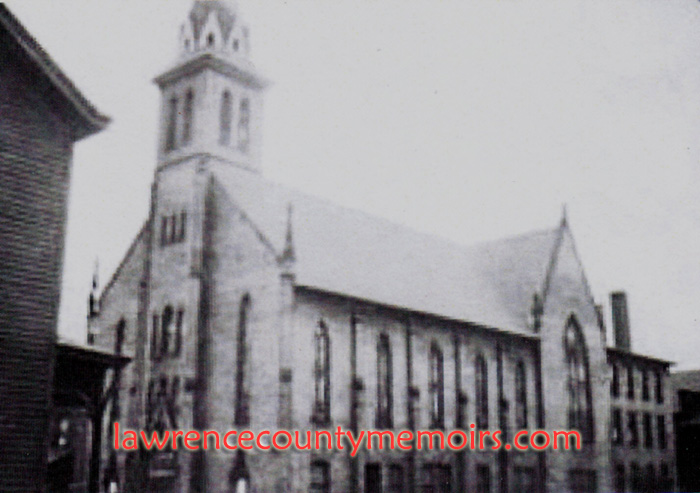 The old St. Vitus Catholic Church, located at the intersection of S. Jefferson Street and Maitland Street. DeMita served as the driving force in seeing that it was built. A newer church was opened alongside it in 1963 and this old church was demolished in c1968. (1932) Full Size |
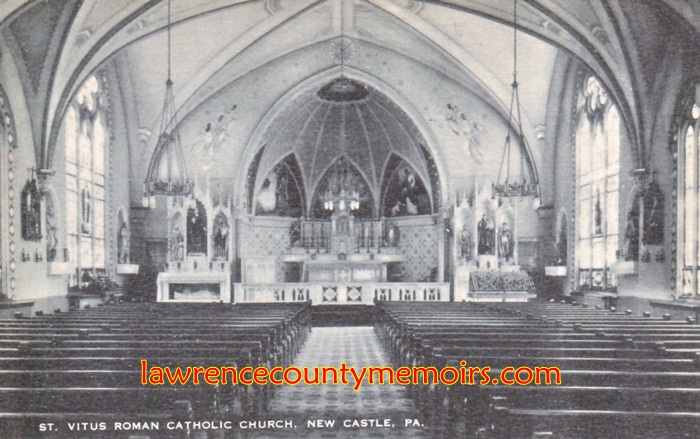 The interior of the old St. Vitus Church. (c1915) Full Size |
 The Reverend DeMita poses with graduates of the parochial school he founded in 1908. (1924) |
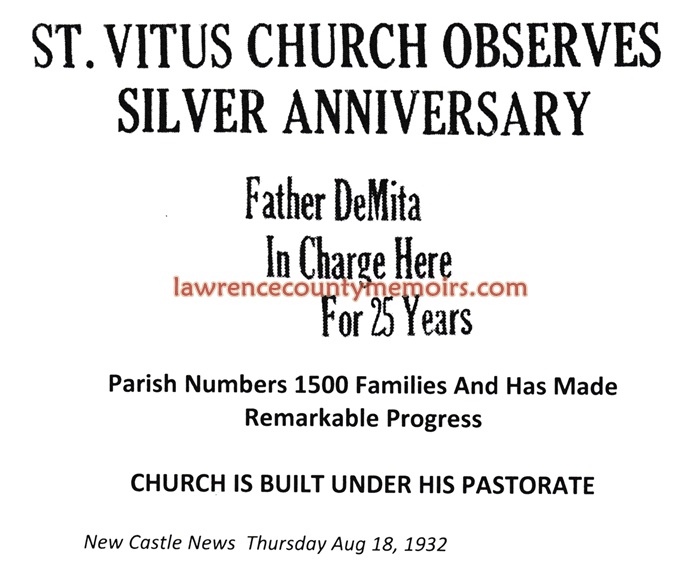 |
 An artist’s rendering of the proposed St. Vitus Catholic School, which was opened next to the church in 1951. (1950) |
 The sisters, known as the Missionary Zelatrices of the Sacred Heart (MZSH), who taught at the parochial school beginning in 1937. The order, based in New Haven CT, is now known as the Apostles of the Sacred Heart of Jesus. (1963) Full Size |
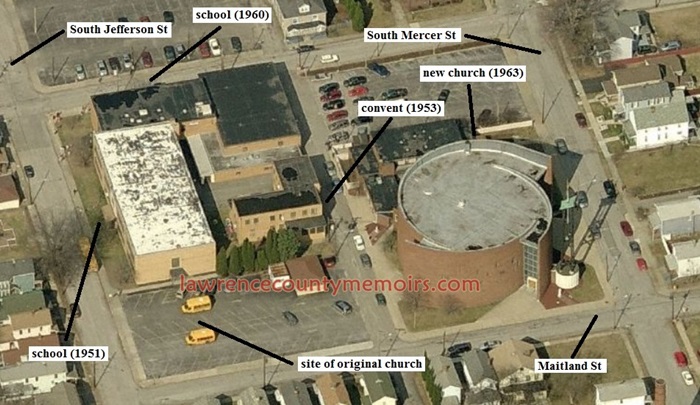 Aerial view of the small campus of St. Vitus Catholic Church. (c2012) |
 The newer St. Vitus Church was dedicated in August 1963 with the Reverend Joseph F. Fabbri serving as pastor. (c1970) Full Size |
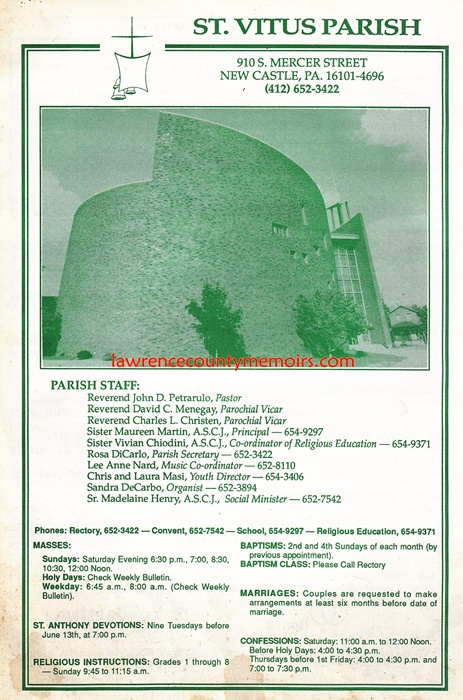 |
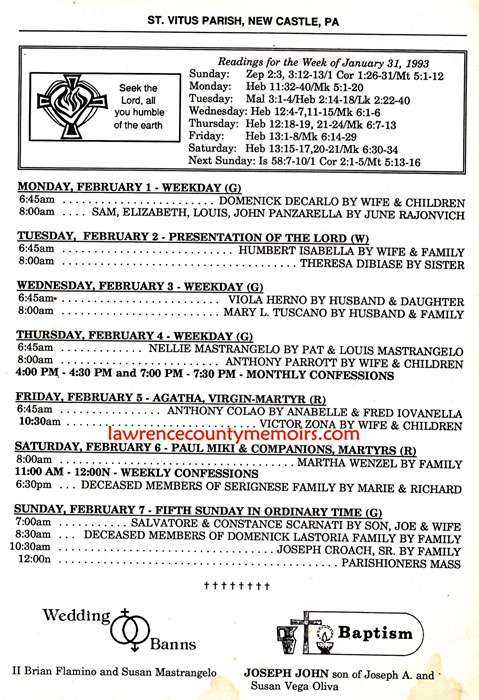 A St. Vitus Parish program from January 31, 1993. Full Size |
 Another view of the St. Vitus Catholic Church. (Jan 2012) |
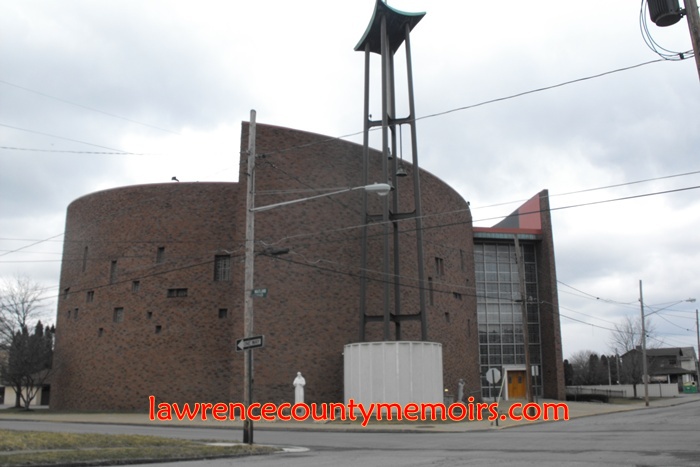 (Mar 2013) Full Size |
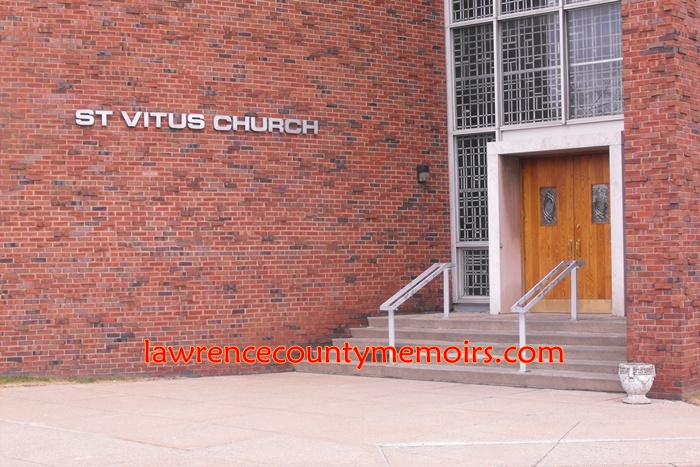 (Mar 2013) |  (Mar 2013) |
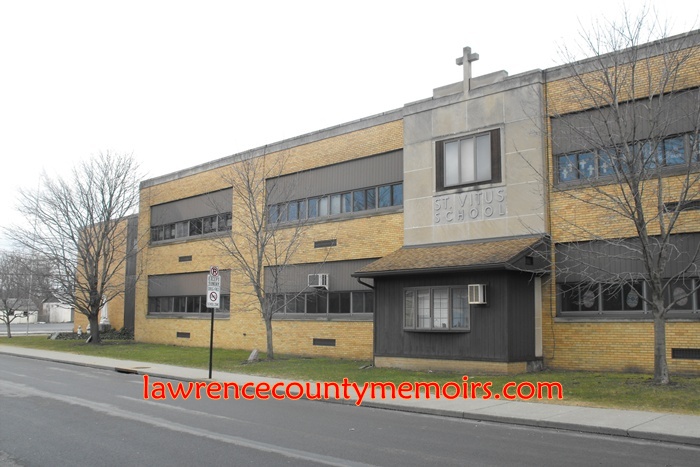 (Mar 2013) Full Size |
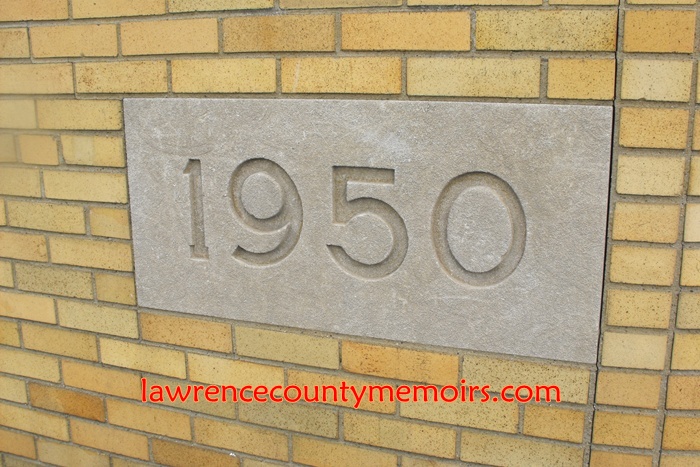 (Mar 2013) | 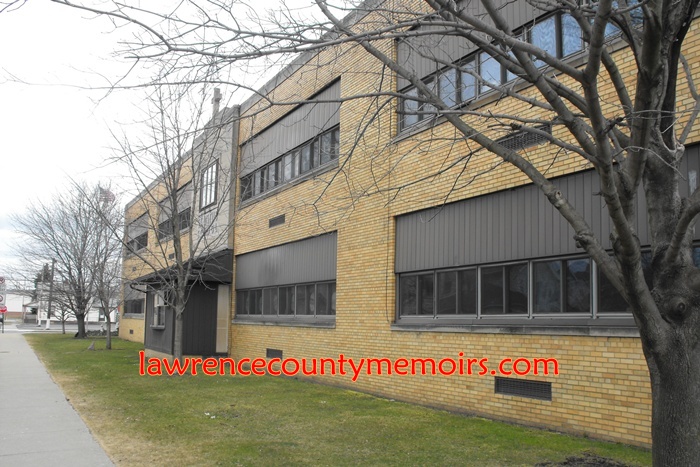 (Mar 2013) |
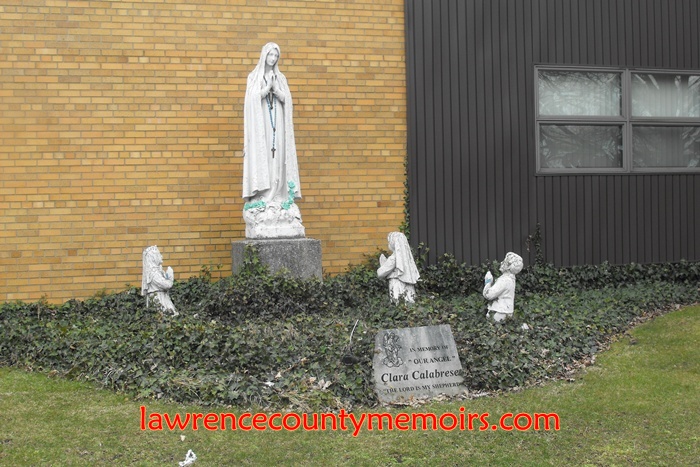 (Mar 2013) |  (Mar 2013) |
 (Mar 2013) Full Size |
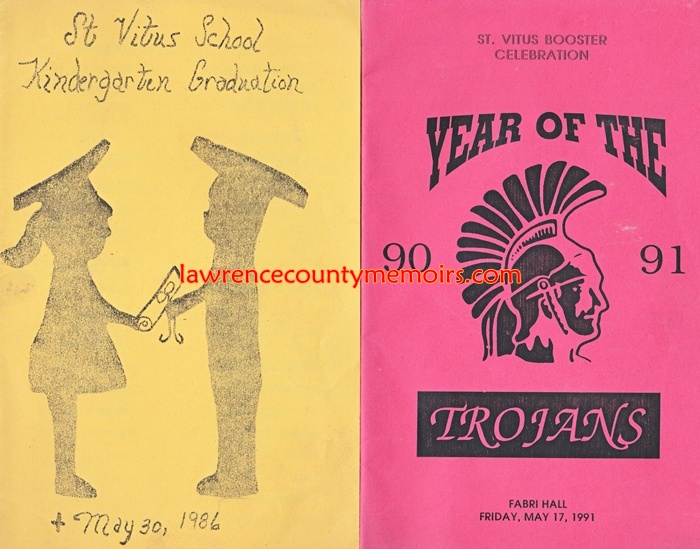 Several late 1980’s-early 1990’s programs from the St. Vitus Parochial School in New Castle. Full Size |





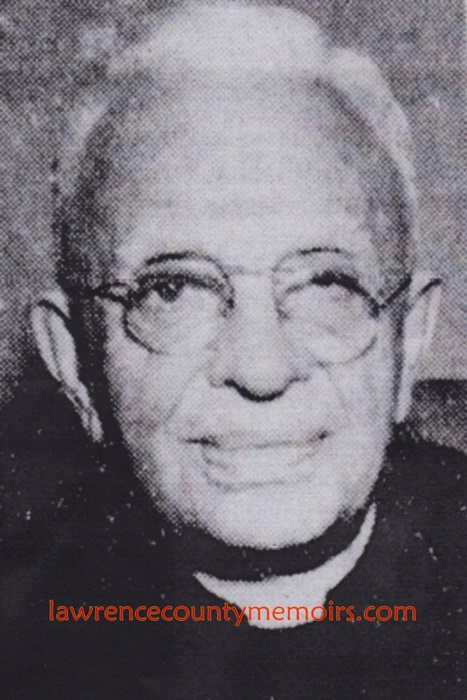


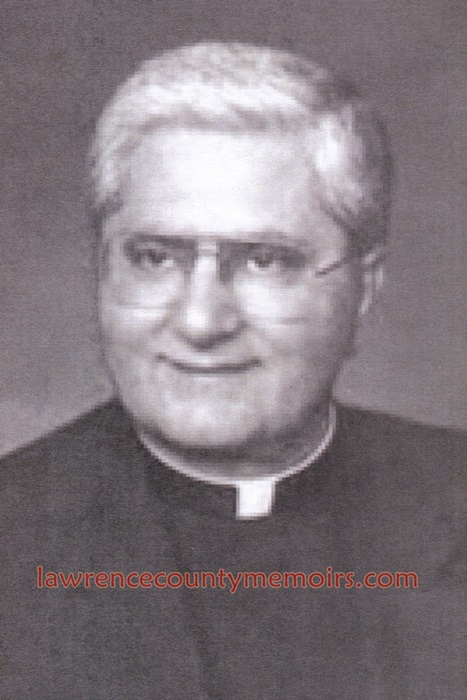

Comments
acc #
I grew up in the old church. Knew Father DeMita very well. Some of us called him “Father Dynamite.” You had to get past him to make your First Holy Communion. You had to sit with him in a tiny room in the school and he would ask you questions. We were lined up in the hall, scared as hell (sorry Sr. Rosemary). When it was my turn, he looked at me and asked, “Are you __ __’s son?” I said “Yes, Father.” He waved his hand and said “Go go go.” I went went went. I still feel the relief. I remember the church, the school, the courtyard, the neighborhood like it was yesterday (it was over 60 years ago). I was always sorry they tore down the church. The design of the new one – well, no comment.
Richard Veri #
I was born in Mahoningtown of Albert and Nancy (Colell) Veri. My grandfather, Charles Colella, donated and built the first alter railing in the old church. Many were confirmed and received their First Holy Communion at that alter. My grandfather asked for no recognition nor payment. When the church was renovated, the alter was moved to the basement of the old church. Many were confirmed and received their first Holy Communion at that alter. My grandfather asked for no recognition nor payment. Most of my friends graduated from St. Vitus School in the last part of the 1950’s. It must be a very fine school because all of them have been successful in life. The Nun’s did a great job!
jimmy rosella #
Shame that High School was built in Hermitage and not New Castle. Parents would have a real choice other than, sending their children to New Castle School District. Can anyone recall the last year Vitus fielded a football team?
Comment